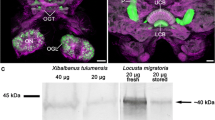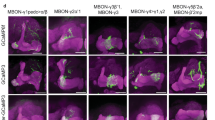Abstract
The mushroom body of the insect brain participates in processing and integrating multimodal sensory information and in various forms of learning. In the field cricket, Gryllus bimaculatus, dopamine plays a crucial role in aversive memory formation. However, the morphologies of dopamine neurons projecting to the mushroom body and their potential target neurons, the Kenyon cells, have not been characterized. Golgi impregnations revealed two classes of Kenyon cells (types I and II) and five different types of extrinsic fibers in the mushroom body. Type I cells, which are further divided into two subtypes (types I core and I surface), extend their dendrites into the anterior calyx, whereas type II cells extend many bushy dendritic branches into the posterior calyx. Axons of the two classes bifurcate between the pedunculus and lobes to form the vertical, medial and γ lobes. Immunocytochemistry to tyrosine hydroxylase (TH), a rate-limiting enzyme in dopamine biosynthesis, revealed the following four distinct classes of neurons: (1) TH-SLP projecting to the distal vertical lobe; (2) TH-IP1 extending to the medial and γ lobes; (3) TH-IP2 projecting to the basal vertical lobe; and (4) a multiglomerular projection neuron invading the anterior calyx and the lateral horn (TH-MPN). We previously proposed a model in the field cricket in which the efficiency of synapses from Kenyon cells transmitting a relevant sensory stimulus to output neurons commanding an appropriate behavioral reaction can be modified by dopaminergic neurons mediating aversive signals and here, we provide putative neural substrates for the cricket’s aversive learning. These will be instrumental in understanding the principle of aversive memory formation in this model species.









Similar content being viewed by others
References
Aso Y, Siwanowicz I, Bräcker L, Ito K, Kitamoto T, Tanimoto H (2010) Specific dopaminergic neurons for the formation of labile aversive memory. Curr Biol 20:1445–1451
Aso Y, Herb A, Ogueta M, Siwanowicz I, Templier T, Friedrich AB, Ito K, Scholz H, Tanimoto H (2012) Three dopamine pathways induce aversive odor memories with different stability. PLoS Genet 8:e1002768
Aso Y, Hattori D, Yu Y, Johnston RM, Iyer NA, Ngo T-TB, Dionne H, Abbott LF, Axel R, Tanimoto H, Rubin GM (2014) The neuronal architecture of the mushroom body provides a logic for associative learning. eLife 3:e04577
Awata H, Watanabe T, Hamanaka Y, Mito T, Noji S, Mizunami M (2015) Knockout crickets for the study of learning and memory: dopamine receptor Dop1 mediates aversive but not appetitive reinforcement in crickets. Sci Rep 5:15885
Awata H, Wakuda R, Ishimaru Y, Matsuoka Y, Terao K, Katata S, Matsumoto Y, Hamanaka Y, Noji S, Mito T, Mizunami M (2016) Roles of OA1 octopamine receptor and Dop1 dopamine receptor in mediating appetitive and aversive reinforcement revealed by RNAi studies. Sci Rep 6:29696
Balling A, Technau GM, Heisenberg M (1987) Are the structural changes in adult Drosophila mushroom bodies memory traces? Studies on biochemical learning mutants. J Neurogenet 4:65–73
Blenau W, Baumann A (2001) Molecular and pharmacological properties of insect biogenic amine receptors: lessons from Drosophila melanogaster and Apis mellifera. Arch Insect Biochem Physiol 48:13–38
Burke CJ, Huetteroth W, Owald D, Perisse E, Krashes MJ, Das G, Gohl D, Silies M, Certel S, Waddell S (2012) Layered reward signalling through octopamine and dopamine in Drosophila. Nature 492:433–437
Claridge-Chang A, Roorda RD, Vrontou E, Sjulson L, Li H, Hirsh J, Miesenböck G (2009) Writing memories with light-addressable reinforcement circuitry. Cell 139:405–415
Cognigni P, Felsenberg J, Waddell S (2018) Do the right thing: neural network mechanisms of memory formation, expression and update in Drosophila. Curr Opin Neurobiol 49:51–58
Denker M, Finke R, Schaupp F, Grün S, Menzel R (2010) Neural correlates of odor learning in the honeybee antennal lobe. Eur J Neurosci 31:119–133
Frambach I, Schürmann F-W (2004) Separate distribution of deutocerebral projection neurons in the mushroom bodies of the cricket brain. Acta Biol Hung 55:21–29
Friggi-Grelin F, Coulom H, Meller M, Gomez D, Hirsh J, Birman S (2003) Targeted gene expression in Drosophila dopaminergic cells using regulatory sequences from tyrosine hydroxylase. J Neurobiol 54:618–627
Giurfa M (2007) Behavioral and neural analysis of associative learning in the honeybee: a taste from the magic well. J Comp Physiol A 193:801–824
Hamada A, Miyawaki K, Honda-sumi E, Tomioka K, Mito T, Ohuchi H, Noji S (2009) Loss-of-function analyses of the fragile X-related and dopamine receptor genes by RNA interference in the cricket Gryllus bimaculatus. Dev Dyn 238:2025–2033
Hamanaka Y, Minoura R, Nishino H, Miura T, Mizunami M (2016) Dopamine- and tyrosine hydroxylase-immunoreactive neurons in the brain of the American cockroach, Periplaneta americana. PLoS ONE 11:e0160531
Heisenberg M (2003) Mushroom body memoir: from maps to models. Nat Rev Neurosci 4:266–275
Hige T (2018) What can tiny mushrooms in fruit flies tell us about learning and memory? Neurosci Res 129:8–16
Hinke W (1961) Das relative postembryonale Wachstum der Hirnteile von Culex pipiens, Drosophila melanogaster und Drosophila mutanten. Z Morph Ökol Tiere 50:81–118
Hörner M, Spörhase-Eichmann U, Helle J, Venus B, Schürmann F-W (1995) The distribution of neurones immunoreactive for ß-tyrosine hydroxylase, dopamine and serotonin in the ventral nerve cord of the cricket, Gryllus bimaculatus. Cell Tissue Res 280:583–604
Ito K, Shinomiya K, Ito M, Armstrong JD, Boyan G, Hartenstein V, Harzsch S, Heisenberg M, Homberg U, Jenett A, Keshishian H, Restifo LL, Rössler W, Simpson JH, Strausfeld NJ, Strauss R, Vosshall LB (2014) A systematic nomenclature for the insect brain. Neuron 81:755–765
Liu C, Plaçais PY, Yamagata N, Pfeiffer BD, Aso Y, Friedrich AB, Siwanowicz I, Rubin GM, Preat T, Tanimoto H (2012) A subset of dopamine neurons signals reward for odour memory in Drosophila. Nature 488:512–516
Malaterre J, Strambi C, Chiang A-S, Aouane A, Strambi A, Cayre M (2002) Development of cricket mushroom bodies. J Comp Neurol 452:215–227
Mao Z, Davis RL (2009) Eight different types of dopaminergic neurons innervate the Drosophila mushroom body neuropil: anatomical and physiological heterogeneity. Front Neural Circuits 3:5
Matsumoto H, Tian J, Uchida N, Watabe-Uchida M (2016) Midbrain dopamine neurons signal aversion in a reward-context-dependent manner. eLife 5:e17328
Menzel R, Leboulle G, Eisenhardt D (2006) Small brains, bright minds. Cell 124:237–239
Mizunami M, Matsumoto Y (2010) Roles of aminergic neurons in formation and recall of associative memory in crickets. Front Behav Neurosci 4:172
Mizunami M, Iwasaki M, Okada R, Nishikawa M (1998) Topography of modular subunits in the mushroom bodies of the cockroach. J Comp Neurol 399:153–161
Mizunami M, Yokohari F, Takahata M (1999) Exploration into the adaptive design of the arthropod “microbrain”. Zool Sci 16:703–709
Mizunami M, Yokohari F, Takahata M (2004) Further exploration into the adaptive design of the arthropod “microbrain”: I. Sensory and memory-processing systems. Zool Sci 21:1141–1151
Mizunami M, Unoki S, Mori Y, Hirashima D, Hatano A, Matsumoto Y (2009) Roles of octopaminergic and dopaminergic neurons in appetitive and aversive memory recall in an insect. BMC Biol 7:46
Mizunami M, Matsumoto Y, Watanabe H, Nishino H (2013) Olfactory and visual learning in cockroaches and crickets. In: Menzel R, Benjamin P (eds) Invertebrate learning and memory. Academic Press, San Diego, pp 549–560
Mizunami M, Hamanaka Y, Nishino H (2015) Toward elucidating diversity of neural mechanisms underlying insect learning. Zool Lett 1:8
Mobbs PG (1982) The brain of the honeybee Apis mellifera. I. The connections and spatial organization of the mushroom bodies. Philos Trans R Soc Lond B 298:309–354
Nakatani Y, Matsumoto Y, Mori Y, Hirashima D, Nishino H, Arikawa K, Mizunami M (2009) Why the carrot is more effective than the stick: different dynamics of punishment memory and reward memory and its possible biological basis. Neurobiol Learn Mem 92:370–380
Nässel DR, Elekes K (1992) Aminergic neurons in the brain of blowflies and Drosophila: dopamine- and tyrosine hydroxylase-immunoreactive neurons and their relationship with putative histaminergic neurons. Cell Tissue Res 267:147–167
Neder R (1959) Allometrisches Wachstum von Hirnteilen bei drei verschieden großen Schabenarten. Zool Jahrb Anat 4:411–464
Owald D, Waddell S (2015) Olfactory learning skews mushroom body output pathways to steer behavioral choice in Drosophila. Curr Opin Neurobiol 35:178–184
Rescorla RA, Wagner AR (1972) A theory of Pavlovian conditioning: variations in the effectiveness of reinforcement and nonreinforcement. In: Black A, Prokasy WR (eds) Classical conditioning II. Academic Press, New York, pp 64–99
Roeder T (2002) Biochemistry and molecular biology of receptors for biogenic amines in locusts. Microsc Res Tech 56:237–247
Schäfer S, Rehder V (1989) Dopamine-like immunoreactivity in the brain and suboesophageal ganglion of the honeybee. J Comp Neurol 280:43–58
Schildberger K (1984) Multimodal interneurons in the cricket brain: properties of identified extrinsic mushroom body cells. J Comp Physiol A 154:71–79
Schultz W (2006) Behavioral theories and the neurophysiology of reward. Annu Rev Psychol 57:87–115
Schultz W (2013) Updating dopamine reward signals. Curr Opin Neurobiol 23:229–238
Schürmann F-W (1973) Über die Struktur der Pilzkörper des Insektenhirns. I I I. Die Anatomie der Nervenfasern in den Corpora pedunculata bei Acheta domesticus L. (Orthoptera): eine Golgi-Studie. Z Zellforsch 145:247–285
Schürmann F-W (2016) Fine structure of synaptic sites and circuits in mushroom bodies of insect brains. Arthropod Struct Dev 45:399–421
Schürmann F-W, Frambach I, Elekes K (2008) GABAergic synaptic connections in mushroom bodies of insect brains. Acta Biol Hung 59:173–181
Schwaerzel M, Monastirioti M, Scholz H, Friggi-Grelin F, Birman S, Heisenberg M (2003) Dopamine and octopamine differentiate between aversive and appetitive olfactory memories in Drosophila. J Neurosci 23:10495–10502
Steinberg EE, Keiflin R, Boivin JR, Witten IB, Deisseroth K, Janak PH (2013) A causal link between prediction errors, dopamine neurons and learning. Nat Neurosci 16:966–973
Tanaka NK, Endo K, Ito K (2012) Organization of antennal lobe-associated neurons in adult Drosophila melanogaster brain. J Comp Neurol 520:4067–4130
Tedjakumala SR, Rouquette J, Boizeau M-L, Mesce KA, Hotier L, Massou I, Giurfa M (2017) A tyrosine-hydroxylase characterization of dopaminergic neurons in the honey bee brain. Front Syst Neurosci 11:47
Terao K, Mizunami M (2017) Roles of dopamine neurons in mediating the prediction error in aversive learning in insects. Sci Rep 7:14694
Terao K, Matsumoto Y, Mizunami M (2015) Critical evidence for the prediction error theory in associative learning. Sci Rep 5:8929
Unoki S, Matsumoto Y, Mizunami M (2005) Participation of octopaminergic reward system and dopaminergic punishment system in insect olfactory learning revealed by pharmacological study. Eur J Neurosci 22:1409–1416
Unoki S, Matsumoto Y, Mizunami M (2006) Roles of octopaminergic and dopaminergic neurons in mediating reward and punishment signals in insect visual learning. Eur J Neurosci 24:2031–2038
Vergoz V, Roussel E, Sandoz JC, Giurfa M (2007) Aversive learning in honeybees revealed by the olfactory conditioning of the sting extension reflex. PLoS One 2:e288
Vogt K, Schnaitmann C, Dylla KV, Knapek S, Aso Y, Rubin GM, Tanimoto H (2014) Shared mushroom body circuits underlie visual and olfactory memories in Drosophila. eLife 3:e02395
Waddell S (2013) Reinforcement signalling in Drosophila; dopamine does it all after all. Curr Opin Neurobiol 23:324–329
Watanabe T, Sadamoto H, Aonuma H (2013) Molecular basis of the dopaminergic system in the cricket Gryllus bimaculatus. Invertebr Neurosci 13:107–123
Watanabe T, Noji S, Mito T (2017) Genome editing in the cricket, Gryllus bimaculatus. In: Hatada I (ed) Genome editing in animals: methods and protocols. Humana Press, New York, pp 219–233
Wendt B, Homberg U (1992) Immunocytochemistry of dopamine in the brain of the locust Schistocerca gregaria. J Comp Neurol 321:387–403
Yu D, Ponomarev A, Davis RL (2004) Altered representation of the spatial code for odors after olfactory classical conditioning: memory trace formation by synaptic recruitment. Neuron 42:437–449
Acknowledgments
We thank Dr. Ian A. Meinertzhagen (Dalhousie University, Canada) for critically reading this manuscript. We are also grateful to Ms. Yoshimi Watanabe for technical support in Golgi impregnation. This work was supported by Grant-in-Aid for Scientific Research (No. 16H04814 and 16K18586) to MM and Grant-in-Aid for Young Scientists (B) No. 26840109 to YH.
Author information
Authors and Affiliations
Corresponding author
Additional information
Publisher’s Note
Springer Nature remains neutral with regard to jurisdictional claims in published maps and institutional affiliations.
Rights and permissions
About this article
Cite this article
Hamanaka, Y., Mizunami, M. Tyrosine hydroxylase-immunoreactive neurons in the mushroom body of the field cricket, Gryllus bimaculatus. Cell Tissue Res 376, 97–111 (2019). https://doi.org/10.1007/s00441-018-2969-9
Received:
Accepted:
Published:
Issue Date:
DOI: https://doi.org/10.1007/s00441-018-2969-9




